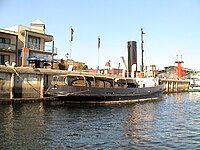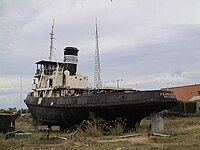
Louis Claude de Saulces de Freycinet was a French Navy officer. He circumnavigated the Earth, and in 1811 published the first map to show a full outline of the coastline of Australia.

Nicolas Thomas Baudin was a French explorer, cartographer, naturalist and hydrographer, most notable for his explorations in Australia and the southern Pacific. He carried a few corms of Gros Michel banana from Southeast Asia, depositing them at a botanical garden on the Caribbean island of Martinique.

Gulf St Vincent, sometimes referred to as St Vincent Gulf, St Vincent's Gulf or Gulf of St Vincent, is the eastern of two large inlets of water on the southern coast of Australia, in the state of South Australia, the other being the larger Spencer Gulf, from which it is separated by Yorke Peninsula. On its eastern side the gulf is bordered by the Adelaide Plains and the Fleurieu Peninsula.
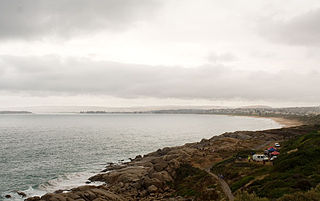
Encounter Bay is a bay in the Australian state of South Australia located on the state's south central coast about 100 kilometres (62 mi) south of the state capital of Adelaide. It was named by Matthew Flinders after his encounter on 8 April 1802 with Nicolas Baudin, the commander of the Baudin expedition of 1800–03. It is the site of both the mouth of the River Murray and the regional city of Victor Harbor. It is one of four "historic bays" located on the South Australian coast.

Trim (1799–1804) was a ship's cat who accompanied Matthew Flinders on his voyages to circumnavigate and map the coastline of Australia in 1801–1803.
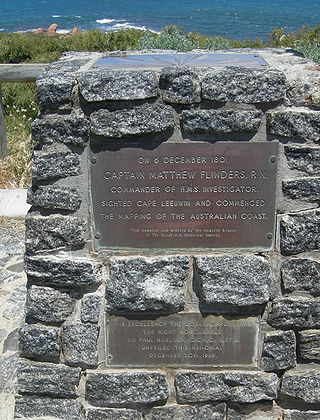
Flinders Bay is a bay that is immediately south of the townsite of Augusta, and close to the mouth of the Blackwood River.

Moonta is a town on the Yorke Peninsula of South Australia, 165 km (103 mi) north-northwest of the state capital of Adelaide. It is one of three towns known as the Copper Coast or "Little Cornwall" for their shared copper mining history.

Captain Matthew Flinders was a British navigator and cartographer who led the first inshore circumnavigation of mainland Australia, then called New Holland. He is also credited as being the first person to utilise the name Australia to describe the entirety of that continent including Van Diemen's Land, a title he regarded as being "more agreeable to the ear" than previous names such as Terra Australis.
The Baudin expedition of 1800 to 1803 was a French expedition to map the coast of New Holland. Nicolas Baudin was selected as leader in October 1800. The expedition started with two ships, Géographe, captained by Baudin, and Naturaliste captained by Jacques Hamelin, and was accompanied by nine zoologists and botanists, including Jean-Baptiste Leschenault de la Tour, François Péron and Charles-Alexandre Lesueur as well as the geographer Pierre Faure.

The New Zealand Maritime Museum Hui Te Ananui A Tangaroa is a maritime museum in Auckland, New Zealand. It is located on Hobson Wharf, adjacent to the Viaduct Harbour in central Auckland. It houses exhibitions spanning New Zealand's maritime history, from the first Polynesian explorers and settlers to modern day triumphs at the America's Cup. Its Maori name is 'Te Huiteanaui-A-Tangaroa' – holder of the treasures of Tangaroa.

HMS Investigator was the mercantile Fram, launched in 1795, which the Royal Navy purchased in 1798 and renamed HMS Xenophon, and then in 1801 converted to a survey ship under the name HMS Investigator. In 1802, under the command of Matthew Flinders, she was the first ship to circumnavigate Australia. The Navy sold her in 1810 and she returned to mercantile service under the name Xenophon. She was probably broken up c.1872.

Géographe was a 20-gun Serpente-class corvette of the French Navy. She was named Uranie in 1797, and renamed Galatée in 1799, still on her building site. Her builder refused to launch her, as he had not been paid to that time. Finally launched in June 1800, she was renamed Géographe on 23 August 1800.

Naturaliste was one of the two-vessel Salamandre-class of galiotes à bombes of the French Navy. Under Jacques Hamelin, and together with Géographe she took part in the exploration of Australia of Nicolas Baudin.

A Voyage to Terra Australis: Undertaken for the Purpose of Completing the Discovery of that Vast Country, and Prosecuted in the Years 1801, 1802, and 1803, in His Majesty's Ship the Investigator was a sea voyage journal written by British mariner and explorer Matthew Flinders. It describes his circumnavigation of the Australian continent in the early years of the 19th century, and his imprisonment by the French on the island of Mauritius from 1804 to 1810.
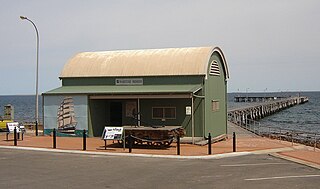
The Port Victoria Maritime Museum is a maritime museum located in South Australia, located on the west coast of the Yorke Peninsula in Port Victoria. It is housed in a cargo shed which was brought out from the United Kingdom in kit form in 1877 and was completed in January 1878. Household goods for the early settlers in the town and surrounding farmlands were brought by steamers from Port Adelaide and stored in the cargo shed until the settlers’ homes were completed.
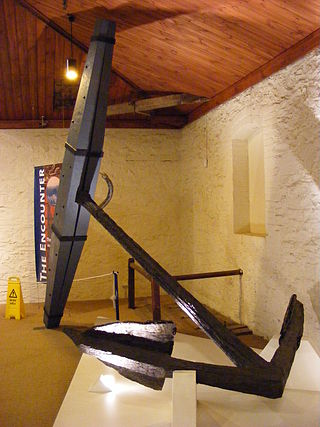
The HMS Investigator Anchors are the two anchors that jettisoned from HMS Investigator on the morning of Saturday, 21 May 1803, by her commander, Matthew Flinders, in order to avoid running aground on Middle Island in the Archipelago of the Recherche on the south coast of New Holland. In 1973, the anchors were located and recovered by members of the Underwater Explorers Club of South Australia (UEC). The recovered anchors became the subject of an ownership dispute between various governments, particularly those of South Australia and Western Australia due to their historic significance as artefacts of a major voyage of European exploration. The dispute was resolved with the ownership of the anchors going to the Australian Government who subsequently gifted one of the anchors to the South Australian Government. The pair of artefacts is also known as Flinders' Anchors.
Cape Hardy is a 20 m (66 ft) high, dune-capped granite headland on the eastern coast of Eyre Peninsula and which protrudes into Spencer Gulf in South Australia. It is located between the towns of Port Neill and Tumby Bay, 10 km (6.2 mi) north-northeast of Lipson Cove.

The MV Nelcebee is an auxiliary schooner that served the South Australian coastal trade from 1883 to 1982.

Yelta is a steam tug which operated in the Australian state of South Australia from 1949 to 1976 within both the Port River and the waters of Gulf St Vincent immediately adjoining the river's mouth. After being laid up for about nine years, she was purchased in 1985 by the Government of South Australia for addition to the collection of the South Australian Maritime Museum as a museum ship. As of 1985, she was considered to be the only remaining steam-powered tug operating within Australian waters.
Peter David Monteath is an Australian historian and academic. He is a professor in Modern European History at Flinders University in South Australia. Monteath's research interests are in modern European and Australian history. He has a particular interest in prisoners of war, internment, and the German presence in Australia and has written extensively on these subjects.



